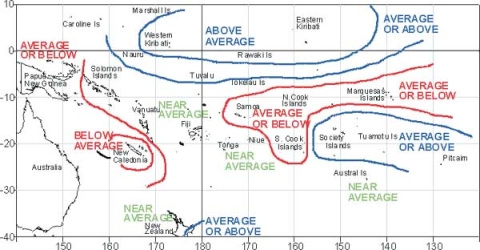Rainfall outlook for August to October 2002
Above average rainfall in equatorial latitudes from west to east
Average or above average rainfall in Tuvalu, the Society Islands and Pitcairn
Average or below average rainfall in Papua New Guinea, New Caledonia, Samoa, Cook Islands, and the Marquesas Islands
Mainly average rainfall in other areas
The El Niño is expected to have an influence on the rainfall in some areas, particularly along the equator and in the Coral Sea.
The South Pacific Convergence Zone is expected to remain fairy inactive east of the date line, with average or below average rainfall likely from Samoa to the Marquesas Islands. Average or below average rainfall is also expected in the southern Cook Islands.
The influence of the El Nino is expected to result in average or below average rainfall from the Coral Sea to New Caledonia, with more convergence and a tendency towards above average rainfall in Kiribati and Tuvalu. Average or above average rainfall is expected in parts of French Polynesia and Pitcairn Island.
Average rainfall is likely elswhere.
Rainfall outlook map for July to September 2002

Probabilities of rainfall departures from average
Broad-scale rainfall patterns and anomalies in the southern tropical Pacific area are estimated from the state of large-scale regional climate factors, such as La Niña or El Niño, their effect on the South Pacific and Tropical Convergence Zones, surface and sub-surface sea temperatures, and computer models of the global climate.
Rainfall estimates for the next three months for Pacific Islands are given in the adjacent table. The tercile probabilities (e.g. 20:30:50) are derived from the interpretation of several global climate models. They correspond to the odds of the observed rainfall being in the lowest (driest) one third of the rainfall distribution, the middle one third, or the highest (wettest) one third of the distribution. On the long-term average, rainfall is equally likely (33% chance) in any tercile.
The probabilities shown express the expected shift in the distribution from the long-term average, based on predictions of oceanic and atmospheric conditions. The amount of inter-model forecast consistency is indicated by the levels of confidence expressed in the table.
| Island Group | Rainfall Outlook | Confidence in the Outlook | |
|---|---|---|---|
| Western Kiribati | 25:30:45 | (Above) | Moderate |
| Eastern Kiribati | 20:30:50 | (Above) | Moderate |
| Tuvalu | 20:45:35 | (Average or above average) | Moderate-Low |
| Society Islands | 25:35:40 | (Average or above average) | Low |
| Pitcairn Islands | 20:45:35 | (Average or above average) | Moderate-Low |
| Solomon Islands | 20:50:30 | (Near average) | Moderate-Low |
| Vanuatu | 25:40:35 | (Near average) | Moderate-Low |
| Wallis & Futuna | 20:45:35 | (Near average) | Moderate-Low |
| Tokelau | 30:40:30 | (Near average) | Moderate-Low |
| Fiji | 30:40:30 | (Near average) | Low |
| Tonga | 35:40:25 | (Near average) | Low |
| Niue | 35:40:25 | (Near average) | Low |
| Austral Islands | 25:50:25 | (Near average) | Low |
| Papua New Guinea | 40:40:20 | ( Average or below average) | Moderate-Low |
| Samoa | 35:40:25 | (Average or below average) | Moderate-Low |
| New Caledonia | 50:35:15 | (Average or below average) | Moderate |
| Northern Cook Islands | 35:40:25 | (Average or below average) | Moderate-Low |
| Southern Cook Islands | 40:40:20 | (Average or below average) | Moderate-Low |
| Marquesas Islands | 35:40:25 | (Average or below average) | Moderate-Low |
Rainfall outcomes as estimated from models and historical records. The third column indicates the probability of bottom (below), middle (average) or top (above) tercile rainfall, where a percentage is given. The rainfall outlook (second column) is subjectively estimated from the probabilities of bottom, middle and top terciles.
